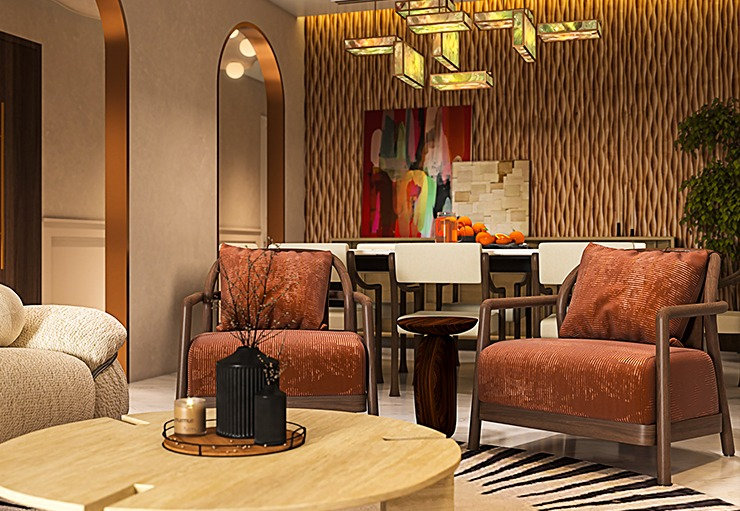Mastering Timeless Interior Design Principles: Essential Strategies for Aspiring Designers
Interior design is not just about arranging furniture or picking colours, it's about creating spaces that are both functional and aesthetically pleasing. The principles of interior design have evolved to consider the well-being, preferences, and diverse needs of users in a holistic approach. From functionality and technology integration to sustainability and wellness-centric design, each principle plays a crucial role in shaping the character and atmosphere of a room in today's rapidly changing world.
Whether you're a student just starting your journey in interior design or an aspiring designer looking to refine your skills, mastering timeless design principles is crucial. In this blog, we'll delve into 10 fundamental principles that every interior design student should master during the interior design course to create spaces that stand the test of time.
1. Balance:
Balance is the foundation of any well-designed space. It's the art of distributing visual weight evenly throughout a room. There are two types of balance: symmetrical and asymmetrical. Symmetrical balance involves arranging elements equally on either side of a central axis, creating a sense of harmony and stability. Asymmetrical balance, on the other hand, involves arranging elements of different visual weights to achieve equilibrium. Mastering both types of balance allows designers to create spaces that feel cohesive and visually pleasing.
2. Scale and Proportion:
Understanding scale and proportion is essential for creating spaces that feel balanced and harmonious. Scale refers to the size of objects in the space they occupy, while proportion refers to the relationship between those objects. Designers must carefully consider the scale and proportion of furniture, fixtures, and accessories to ensure they complement the size of the room and each other.
3. Harmony and Unity:
Harmony and unity are achieved when all elements of a design work together to create a cohesive whole. This involves using consistent colours, patterns, and textures throughout a space to create a sense of harmony. By maintaining harmony and unity, designers can ensure that every element contributes to the overall aesthetic and functionality of the room.
4. Rhythm and Repetition:
Rhythm and repetition add visual interest and movement to a space. Rhythm refers to the flow or progression of elements within a room, while repetition involves using the same or similar elements throughout the space. By incorporating rhythm and repetition, designers can create a sense of continuity and coherence that guides the eye through the space.
5. Emphasis and Focal Point:
Every well-designed space needs a focal point – a feature that draws the eye and serves as the visual anchor of the room. Whether it's a fireplace, a piece of artwork, or a statement piece of furniture, the focal point should command attention and set the tone for the rest of the space. Emphasis involves highlighting the focal point while also balancing it with the other elements in the room.
6. Contrast:
Contrast adds visual interest and depth to a space by juxtaposing different elements. This can include contrasting colours, textures, shapes, or styles. By incorporating contrast, designers can create dynamic and engaging spaces that capture attention and evoke emotion.
7. Functionality:
Functionality is a key consideration in interior design, as spaces need to be both beautiful and practical. Designers must carefully consider the needs and lifestyle of the occupants when planning layouts and selecting furnishings. Every element should serve a purpose and contribute to the overall functionality of the space.
8. Light and Space:
Lighting plays a crucial role in interior design, as it affects the mood, ambience, and functionality of a space. Natural light should be maximized whenever possible, while artificial lighting should be carefully planned to create the desired atmosphere. During an interior design course, students get to know that designers must consider the use of space and how it influences the flow and function of the room.
9. Texture:
Texture adds tactile and visual interest to a space, making it feel more inviting and dynamic. This can include materials such as wood, stone, fabric, and metal. By incorporating a variety of textures, designers can create depth and dimension that enhance the overall aesthetic of the room.
10. Personalization:
Finally, every well-designed space should reflect the personality and preferences of its occupants. Whether it's through artwork, accessories, or custom furnishings, designers should strive to incorporate elements that resonate with the people who will be using the space. Personalization adds warmth and character to a room, making it feel truly unique and inviting.
Mastering these timeless interior design principles is essential for aspiring designers looking to create spaces that are not only beautiful but also functional and enduring. By understanding and applying these principles during an interior design course students can develop the skills and confidence needed to excel in the field of interior design and create spaces that inspire and delight for years to come.
INIFD Bhubaneswar provides training to students to sharpen their skills in decor to understand the increasing needs of the market and create products that are in line with client or customer requirements aiming to combine the creativity of artistic minds with technical proficiency. Apart from getting a quality education, the students of INIFD Bhubaneswar also get hands-on experience at major events. To know more about them please visit the official website https://www.inifdbhubaneswar.com/




